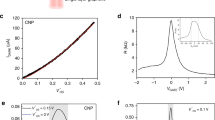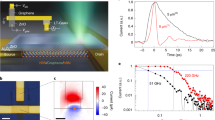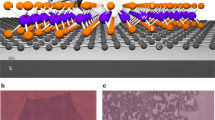Abstract
The combination of its high electron mobility1,2,3,4,5, broadband absorption6 and ultrafast luminescence7,8,9,10 make graphene attractive for optoelectronic and photonic applications11,12,13, including transparent electrodes14, mode-locked lasers15 and high-speed optical modulators16. Photo-excited carriers that have not cooled to the temperature of the graphene lattice are known as hot carriers, and may limit device speed and energy efficiency. However, their roles in charge and energy transport are not fully understood17,18,19,20. Here, we use time-resolved scanning photocurrent microscopy to demonstrate that hot carriers, rather than phonons, dominate energy transport across a tunable graphene p–n junction excited by ultrafast laser pulses. The photocurrent response time varies from 1.5 ps at room temperature to 4 ps at 20 K, implying a fundamental bandwidth of ∼500 GHz (refs 12, 13, 21). Gate-dependent pump–probe measurements demonstrate that both thermoelectric and built-in electric field effects contribute to the photocurrent, with the contribution from each depending on the junction configuration. The photocurrent produced by a single pulsed laser also displays multiple polarity reversals as a function of carrier density, which is a possible signature of impact ionization19,22,23.
This is a preview of subscription content, access via your institution
Access options
Subscribe to this journal
Receive 12 print issues and online access
$259.00 per year
only $21.58 per issue
Buy this article
- Purchase on Springer Link
- Instant access to full article PDF
Prices may be subject to local taxes which are calculated during checkout




Similar content being viewed by others
References
Balandin, A. A. et al. Superior thermal conductivity of single-layer graphene. Nano Lett. 8, 902–907 (2008).
Du, X., Skachko, I., Barker, A., & Andrei, E. Y. Approaching ballistic transport in suspended graphene. Nature Nanotech. 3, 491–495 (2008).
Geim, A. K. & Novoselov, K. S. The rise of graphene. Nature Mater. 6, 183–191 (2007).
Meric, I. et al. Current saturation in zero-bandgap, top-gated graphene field-effect transistors. Nature Nanotech. 3, 654–659 (2008).
Novoselov, K. S. et al. Two-dimensional gas of massless Dirac fermions in graphene. Nature 438, 197–200 (2005).
Nair, R. R. et al. Fine structure constant defines visual transparency of graphene. Science 320, 1308 (2008).
Gokus, T. et al. Making graphene luminescent by oxygen plasma treatment. ACS Nano 3, 3963–3968 (2009).
Liu, W-T. et al. Nonlinear broadband photoluminescence of graphene induced by femtosecond laser irradiation. Phys. Rev. B 82, 081408 (2010).
Lui, C. H., Mak, K. F., Shan, J. & Heinz, T. F. Ultrafast photoluminescence from graphene. Phys. Rev. Lett. 105, 127404 (2010).
Stöhr, R. J., Kolesov, R., Pflaum, J. & Wrachtrup, J. Fluorescence of laser-created electron-hole plasma in graphene. Phys. Rev. B 82, 121408 (2010).
Bonaccorso, F., Sun, Z., Hasan, T. & Ferrari, A. C. Graphene photonics and optoelectronics. Nature Photon. 4, 611–622 (2010).
Urich, A., Unterrainer, K. & Mueller, T. Intrinsic response time of graphene photodetectors. Nano Lett. 11, 2804–2808 (2011).
Xia, F., Mueller, T., Lin, Y-m., Valdes-Garcia, A. & Avouris, P. Ultrafast graphene photodetector. Nature Nanotech. 4, 839–843 (2009).
Bae, S. et al. Roll-to-roll production of 30-inch graphene films for transparent electrodes. Nature Nanotech. 5, 574–578 (2010).
Sun, Z. et al. Graphene mode-locked ultrafast laser. ACS Nano 4, 803–810 (2010).
Liu, M. et al. A graphene-based broadband optical modulator. Nature 474, 64–67 (2011).
Lemme, M. C. et al. Gate-activated photoresponse in a graphene p–n junction. Nano Lett. 11, 4134–4137 (2011).
Peters, E. C., Lee, E. J. H., Burghard, M. & Kern, K. Gate dependent photocurrents at a graphene p–n junction. Appl. Phys. Lett. 97, 193102 (2010).
Song, J. C. W., Rudner, M. S., Marcus, C. M. & Levitov, L. S. Hot carrier transport and photocurrent response in graphene. Nano Lett. 11, 4688–4692 (2011).
Gabor, N. M. et al. Hot carrier-assisted intrinsic photoresponse in graphene. Science 334, 648–652 (2011).
Mueller, T., Xia, F. & Avouris, P. Graphene photodetectors for high-speed optical communications. Nature Photon. 4, 297–301 (2010).
Kim, R., Perebeinos, V. & Avouris, P. Relaxation of optically excited carriers in graphene. Phys. Rev. B 84, 075449 (2011).
Perebeinos, V. & Avouris, P. Impact excitation by hot carriers in carbon nanotubes. Phys. Rev. B 74, 121410 (2006).
Lee, E. J. H., Balasubramanian, K., Weitz, R. T., Burghard, M. & Kern, K. Contact and edge effects in graphene devices. Nature Nanotech. 3, 486–490 (2008).
Xu, X., Gabor, N. M., Alden, J. S., van der Zande, A. M. & McEuen, P. L. Photo-thermoelectric effect at a graphene interface junction. Nano Lett. 10, 562–566 (2009).
Mai, S., Syzranov, S. V. & Efetov, K. B. Photocurrent in a visible-light graphene photodiode. Phys. Rev. B 83, 033402 (2011).
Park, J., Ahn, Y. H. & Ruiz-Vargas, C. Imaging of photocurrent generation and collection in single-layer graphene. Nano Lett. 9, 1742–1746 (2009).
Xia, F. et al. Photocurrent imaging and efficient photon detection in a graphene transistor. Nano Lett. 9, 1039–1044 (2009).
Rao, G., Freitag, M., Chiu, H-Y., Sundaram, R. S. & Avouris, P. Raman and photocurrent imaging of electrical stress-induced pn junctions in graphene. ACS Nano 5, 5848–5854 (2011).
Sun, D. et al. Ultrafast relaxation of excited Dirac fermions in epitaxial graphene using optical differential transmission spectroscopy. Phys. Rev. Lett. 101, 157402 (2008).
Butscher, S., Milde, F., Hirtschulz, M., Malic, E. & Knorr, A. Hot electron relaxation and phonon dynamics in graphene. Appl. Phys. Lett. 91, 203103 (2007).
Bistritzer, R. & MacDonald, A. H. Electronic cooling in graphene. Phys. Rev. Lett. 102, 206410 (2009).
Tse, W-K. & Das Sarma, S. Energy relaxation of hot Dirac fermions in graphene. Phys. Rev. B 79, 235406 (2009).
Grosse, K. L., Bae, M-H., Lian, F., Pop, E. & King, W. P. Nanoscale Joule heating, Peltier cooling and current crowding at graphene–metal contacts. Nature Nanotech. 6, 287–290 (2011).
Acknowledgements
The authors thank Z. Zhong for helpful suggestions on device fabrication and T. Norris for useful discussions. X. Xu acknowledges support from DARPA YFA. The research was supported in part by the US Department of Energy, Office of Basic Energy Sciences, Division of Materials Sciences and Engineering (DE-SC0002197). D. Sun acknowledges partial support from IBM (4910031201). A. Jones was supported by the NSF Graduate Research Fellowship (DGE-0718124). Device fabrication was performed at the University of Washington Nanotechnology User Facility funded by the NSF. X. Xu thanks B. Heckel, B. Blinov and L. Sorensen for help with the laboratory set-up.
Author information
Authors and Affiliations
Contributions
X.X. conceived the experiments. G.A. fabricated the devices, assisted by A.J., J.R. and D.S. Measurements were performed by D.S., with X.X., G.A. and D.H.C. providing assistance. W.Y. contributed to the theoretical explanation. All authors discussed the results and contributed to writing the manuscript.
Corresponding author
Ethics declarations
Competing interests
The authors declare no competing financial interests.
Supplementary information
Rights and permissions
About this article
Cite this article
Sun, D., Aivazian, G., Jones, A. et al. Ultrafast hot-carrier-dominated photocurrent in graphene. Nature Nanotech 7, 114–118 (2012). https://doi.org/10.1038/nnano.2011.243
Received:
Accepted:
Published:
Issue Date:
DOI: https://doi.org/10.1038/nnano.2011.243
This article is cited by
-
CsPbBr3/graphene nanowall artificial optoelectronic synapses for controllable perceptual learning
PhotoniX (2023)
-
Single-material MoS2 thermoelectric junction enabled by substrate engineering
npj 2D Materials and Applications (2023)
-
Gate-controlled suppression of light-driven proton transport through graphene electrodes
Nature Communications (2023)
-
Photocurrent as a multiphysics diagnostic of quantum materials
Nature Reviews Physics (2023)
-
Ultrafast intrinsic optical-to-electrical conversion dynamics in a graphene photodetector
Nature Photonics (2022)



